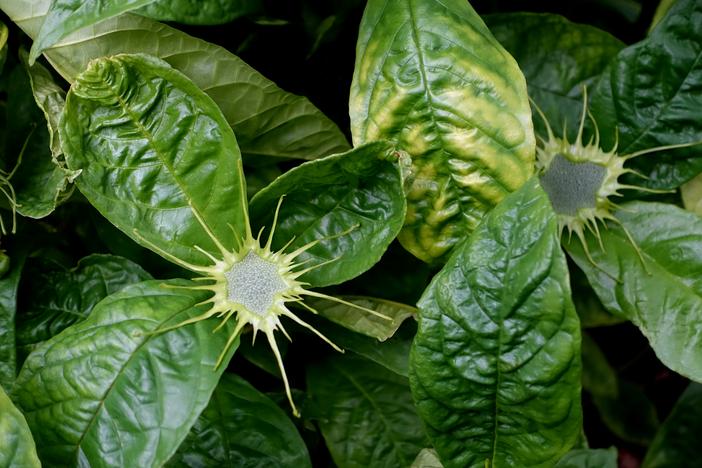African Dorstenia
(Dorstenia barteri)
African Dorstenia (Dorstenia barteri)
/
/

Daderot
CC0
Image By:
Daderot
Recorded By:
Copyright:
CC0
Copyright Notice:
Photo by: Daderot | License Type: CC0 | License URL: http://creativecommons.org/publicdomain/zero/1.0/deed.en | Uploader: Daderot | Publisher: Wikipedia Commons


Estimated Native Range
Summary
Dorstenia barteri, commonly known as the African Dorstenia, is a perennial herb native to the understory of tropical rainforests in West Africa. It typically grows up to 24 inches tall and features a creeping rooting base that allows it to spread. The leaves are papery, obovate-elliptic, and the plant is known for its unique inflorescences, which consist of a central flower head surrounded by unequal bract-arms, resembling a fan. The inflorescences are not particularly showy but are intriguing to plant enthusiasts due to their unusual structure. Dorstenia barteri blooms throughout the year in its native habitat.
In cultivation, African Dorstenia is valued for its medicinal properties and as an exotic ornamental. It is used in West African folk medicine for its anti-microbial, anti-reverse transcriptase, and anti-inflammatory properties. Gardeners may grow it as a conversation piece or for ethnobotanical collections. It prefers a humid, tropical-like environment with indirect light, making it suitable for indoor cultivation or greenhouse environments outside its native range. It requires well-draining soil and consistent moisture but should not be waterlogged. While it is not commonly used in large-scale landscaping, it can be an interesting addition to terrariums or as a potted specimen in botanical gardens. Potential problems include root rot if overwatered and mealybugs or spider mites if the humidity is too low.CC BY-SA 4.0
In cultivation, African Dorstenia is valued for its medicinal properties and as an exotic ornamental. It is used in West African folk medicine for its anti-microbial, anti-reverse transcriptase, and anti-inflammatory properties. Gardeners may grow it as a conversation piece or for ethnobotanical collections. It prefers a humid, tropical-like environment with indirect light, making it suitable for indoor cultivation or greenhouse environments outside its native range. It requires well-draining soil and consistent moisture but should not be waterlogged. While it is not commonly used in large-scale landscaping, it can be an interesting addition to terrariums or as a potted specimen in botanical gardens. Potential problems include root rot if overwatered and mealybugs or spider mites if the humidity is too low.CC BY-SA 4.0
Plant Description
- Plant Type: Herb
- Height: 0.5-2 feet
- Width: 0.5-2 feet
- Growth Rate: Moderate
- Flower Color: Green
- Flowering Season: Spring, Summer, Fall
- Leaf Retention: Deciduous
Growth Requirements
- Sun: Part Shade
- Water: Medium
- Drainage: Fast
Common Uses
Low Maintenance, Potted Plant
Natural Habitat
Native to the understory of tropical rainforests in West Africa
Other Names
Common Names: Multiflower Fig, Dorstenia
Scientific Names: , Dorstenia barteri,
GBIF Accepted Name: